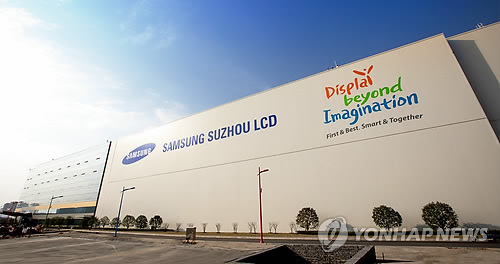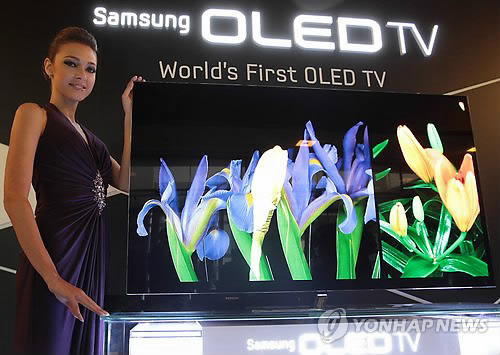Korean display giants -- Samsung Display and LG Display -- will continue to face headwinds in the world’s liquid crystal display sector as their Chinese rivals are upping the ante, according to market analysts.
Citing prolonged oversupply, dipping demand and increasing clout of Chinese display-makers, the analysts from Korea, Taiwan and Japan all gave a dismal outlook over this year’s LCD market during the Korea Display Conference 2016 in Seoul this week.
 |
Samsung Display’s LCD factory in Suzhou, China (Yonhap) |
“Chinese display-makers' shipment volume of 32-inch LCD panels accounted for around 70 percent of their entire LCD shipments last year, but the figure will likely drop to 60 percent as they would instead turn their shift toward larger-size panels, a relative stronghold of the Korean firms,” market research firm IHS Technology director Chung Yoon-sung said.
He added, “2018 will be the year when the scale is tilted in favor of the Chinese players in the entire LCD market.”
Bearing the brunt of China’s increasing presence in the LCD market, Samsung’s LCD business is anticipated to post an operating loss of 400 billion won ($344 million) in the first quarter of this year, according to some estimates by local investment firms.
As if reflecting the downward trend of its LCD business, Samsung Display has shut down five LCD production lines in Korea last year while LG Display has stopped operating several LCD production lines in recent months.
Their Chinese rivals, on the other hand, are fast rising thanks to the backing of Chinese central and local government, such as tax benefits and cheap land to build factories.
Chinese display manufacturer BOE’s market share by shipment almost doubled from 6.8 percent in the first quarter of 2014 to 11.6 percent in the fourth quarter of 2015, while that of LG Display decreased from 25 percent to 23.8 percent during the cited period. Samsung Display saw its market share drop from 21.2 percent to 19.1 percent.
Government subsidies granted to BOE and Shenzhen-based display firm China Star from 2011 to 2015 are said to have exceeded 12.765 billion yuan ($1.97 billion) and 8.042 billion yuan, respectively, according to IHS.
With the anticipated increase in supply of large displays, the prices of big-screen TVs, especially those measuring 55 or 65 inches (134 or 165 centimeters), will significantly drop, which will sequentially bring down the prices of once-thought-to-be premium TV products, the IHS director added.
The sales volume of 55-inch ultra-high definition TVs surpassed that of 55-inch full HD TVs last year, according to the research firm.
A UHD TV has four times more pixels than a full HD TV, meaning the first delivers four times the picture resolution than the latter.
“Winter is coming for the Korean display-makers,” said IHS director Ricky Park, adding they would not be able to dodge the impact of the prolonged global economic recession, low demand in the information technology sector and fierce competition.
In order for the Korean firms to overcome obstacles in the competitive market, market analysts said the Korean players would have to put focus on tightening their grips on high-end segments like the one for organic light-emitting diode displays.
 |
A model poses with Samsung Electronics‘ organic light-emitting diode TV. (Yonhap) |
Samsung, an archrival as well as a strategic ally of Apple, is also ramping up its OLED production for both mobile phones and TVs in the coming years.
Samsung is taking the lead in the OLED market for mobile devices. In the second half of 2015, it took a 71 percent market share by shipment, to increased adoption of OLED panels by Chinese phone-makers.
LGD is also flexing its muscles in the OLED sector not only for TVs, but also for handsets. The company reportedly started supplying flexible displays to Chinese smartphone-maker Xiaomi.
“Most of the significant investments in Korea in the next two years are expected to be focus on AMOLED,” Park said.
The imminent merger between Hong Hai, better known as Foxconn, and Japan-based display firm Sharp will likely accelerate the growth of the OLED market, as it is expected to supply OLED panels for Apple’s iPhones with flexible displays, to be released in 2018.
By Kim Young-won (
wone0102@heraldcorp.com)









